MP Board Class 7th Science Solutions Chapter 2 Nutrition in Animals
Nutrition in Animals Intext Questions
Question 1.
Paheli wants to know how food moves in the opposite direction during vomiting?
Answer:
The food pipe runs along the neck and the chest. Food is pushed down by movement of the wall of the food pipe. Actually this movement takes place throughout the alimentary canal and pushes the food downwards. At times the food is not accepted by our stomach and is vomited out.
Question 2.
Paheli wants to know why these animals cannot chew food properly at the time they take it in?
Answer:
The ruminants mainly feed on grass and bush which primarily contain cellulose or roughage. The grass is rich in cellulose, so lot of chewing and saliva are need. Thus, the ruminants need to chew the grass for long time. If they chew for long while eating, they will get less time to eat.
![]()
Question 3.
Boojho wants to know why we cannot digest cellulose like the cattle do?
Answer:
Ruminants have a large sac – like structure between the small intestine and large intestine. The cellulose of the food is digested here by the action of certain bacteria which are not present in humans.
Activities
Activity 1
What is the type of food and mode of feeding of the following animals? Write down your observations in the given Table. You may find the list of modes of feeding given below the Table helpful.
Table 1:
Various modes of feeding
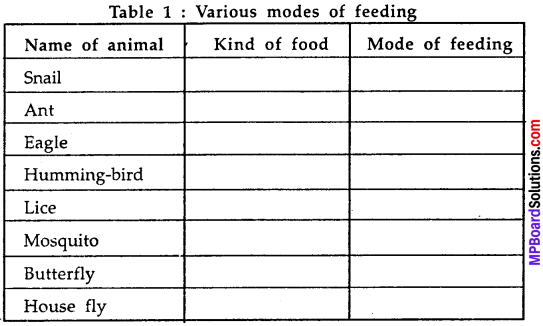
(Scraping, chewing, brewing, capturing and swallowing, sucking etc.)
Answer:
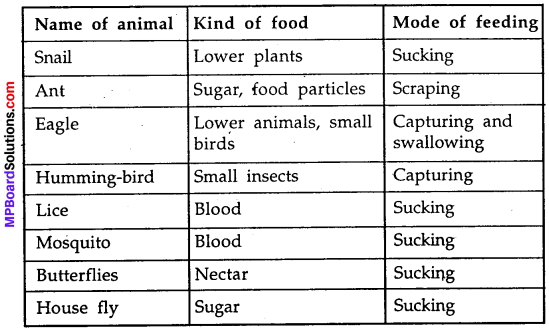
Activity 2
Wash your hands Look into the mirror and count your teeth. Use your index finger to feel the teeth. How many kinds of teeth could you find? Take a piece of an apple or bread and eat it. Which teeth do you use for biting and cutting and which ones for piercing and tearing? Also find out the ones that are used for chewing and grinding?
Record your observations in Table 2.
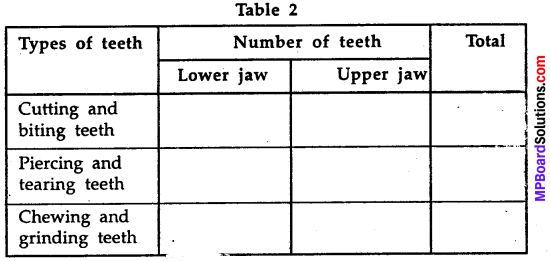
Answer:
Four.
- Incisors are used for biting and cutting.
- Canines are used for piercing and tearing.
- Premolars and molars are used for chewing and grinding.
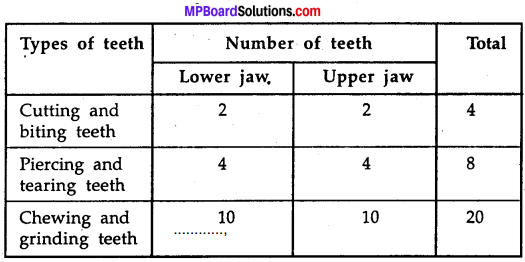
Nutrition in Plants Text book Exercises
Question 1.
Fill in the blanks:
- The main steps of digestion in humans are …………, …………, …………, …………, and …………
- The largest gland in the human body is …………
- The stomach releases hydrochloric acid and ………… juices which act on food.
- The inner wall of the small intestine has many finger – like outgrowths called …………
- Amoeba digests its food in the …………
Answer:
- Ingestion, digestion, absorption, assimilation and egestion
- Liver
- Digestive
- Villi
- Food vacuole.
![]()
Question 2.
Mark ‘T’ if the statement is true and ‘F’ if it is false:
- Digestion of starch starts in the stomach. (T/F)
- The tongue helps in mixing food with saliva. (T/F)
- The gall bladder temporarily stores bile. (T/F)
- The ruminants bring back swallowed grass into their mouth and chew it for some time. (T/F)
Answer:
- False (F)
- True (T)
- True (T)
- True (T)
Question 3.
Tick (S) mark the correct answer in each of the following:
Question (a)
Fat is completely digested in the –
(i) Stomach
(ii) Mouth
(iii) Small intestine
(iv) Large intestine
Answer:
(iii) Small intestine
Question (b)
Water from the undigested food is absorbed mainly in the –
(i) Stomach
(ii) Food pipe
(iii) Small intestine
(iv) Large intestine
Answer:
(iv) Large intestine
Question 4.
Match the items of Column I with those given in Column II:

Answer:
(i) (b)
(ii) (c)
(iii) (a).
![]()
Question 5.
What are villi? What is their location and function?
Answer:
The inner walls of the small intestine have thousands of finger – like outgrowths, these are called villi. They are situated in the small intestine.
Functions of Villi:
- The villi increase the surface area for absorption of the digested food.
- Each villus has a network of thin and small blood vessels close to its surface.
- The surface of the villi absorbs the digested food materials.
The absorbed substances are transported via the blood vessels to different organs of the body where they are used to build complex substances such as the proteins required by the body.
Question 6.
Where is the bile produced? Which component of the food does it digest?
Answer:
The liver secretes bile juice that is stored in a sea called gall bladder. Bile juice digests fat.
Question 7.
Name the types of carbohydrate that can be digested by ruminants but not by humans. Give the reason also?
Answer:
The grass is rich in cellulose, a type of carbohydrate. Many animals including humans cannot digest cellulose. The cellulose can be digested by ruminants but not by humans because they have a large sac – like structure between the small intestine and large intestine. The cellulose of the food is digested here by the action of certain bacteria which are not present in humans.
![]()
Question 8.
Why do we get instant energy from glucose?
Answer:
We get instant energy from glucose because glucose is the simplest form of carbohydrate which can be broken down easily to give energy.
Question 9.
Which part of the digestive canal is involved in:
- Absorption of food ……………….
- Chewing of food
- ……………….
- killing of bacteria …………………..
- Complete digestion of food ………………….
- Formation of faeces ……………….
Answer:
- Small intestine
- Buccal cavity
- Stomach
- Small intestine
- Large intestine.
Question 10.
Write one similarity and one difference between the nutrition in Amoeba and human beings?
Answer:
Similarity:
Both amoeba and human use the process of digestion involves ingestion, digestion, absorption, assimilation and egestion.
Difference:
Human needs to chew food whereas in amoeba, there is no chewing.
Question 11.
Match the items of Column I with suitable items in Column II
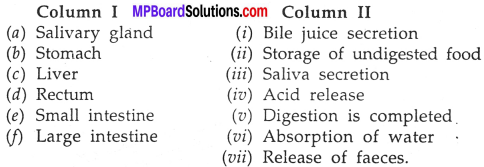
Answer:
(a) (iii)
(b) (iv)
(c) (i)
(d) (vii)
(e) (v)
(f) (vi).
![]()
Question 12.
Label Fig of the digestive system
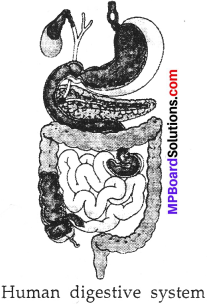
Answer:
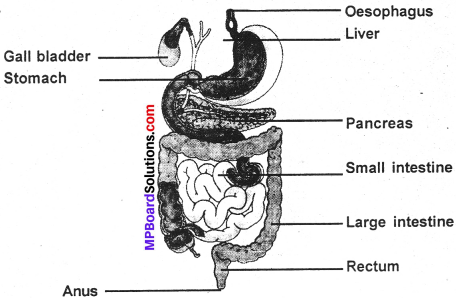
Question 13.
Can we survive only on raw, leafy vegetables/grass? Discuss.
Answer:
No, because to live healthy life we need a complete balance of all nutrients. Raw green vegetables may have cellulose which can not be digested by us. Thus, only green leafy vegetbles will not solve the purpose.
Extended Learning Activities and Project
Question 1.
Visit a doctor and find out:
- Under what conditions does a patient need to be on a drip of glucose?
- Till when does a patient need to be given glucose?
- How does glucose help the patient recover?
Write the answers in your notebook.
Answer:
1. A patient is given glucose. When he/she is unable to eat food, unable to digest food.
2. Till the crisis is over.
3. Glucose chip has the following positive points to recover patient:
- It need not be digested
- It need not be eaten
- It gives instant energy.
Question 2.
Find out what vitamins are and get the following information:
- Why are vitamins necessary in the diet?
- Which fruits or vegetables should be eaten regularly to get vitamins?
Answer:
- Vitamins help to protect against diseases. They also help m proper functioning of body and brain.
- All green leafy vegetables, fruits, milk, egg, butter, etc. provide vitamins.
![]()
Question 3.
Collect data from your friends, neighbours and classmates to know more about milk teeth?
Tabulate your data. One way of doing it is given below:
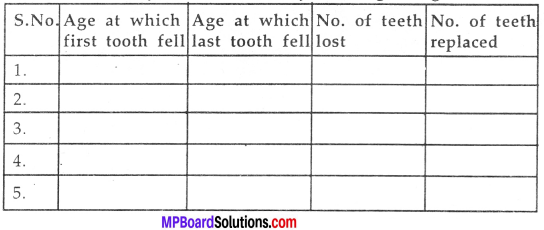
Find out from at least twenty children and find the average age. at which children lose the milk teeth. You may take help of your friends.
Answer:
Do with the help of your subject teacher.
Nutrition in Plants Additional Important Questions
Objective Type Questions
Question 1.
Choose the correct alternative:
Question (i)
Which one of the following is not an excretory organ –
(a) Oesophagus
(b) Skin
(c) Lever
(d) Kidney.
Answer:
(a) Oesophagus
Question (ii)
How many times heart of an healthy person beats in one minute –
(a) 70
(b) 71
(c) 72
(d) 73.
Answer:
(c) 72
![]()
Question (iii)
Which organ produces bile –
(a) Liver
(b) Stomach
(c) Gall bladder
(d) Pancreas.
Answer:
(a) Liver
Question (iv)
The undigested food is eliminated through –
(a) Anus
(b) Lungs
(c) Caecum
(d) Colon.
Answer:
(a) Anus
Question (v)
The teeth which help in biting the food are –
(a) Incisors
(b) Canines
(c) Premolars
(d) Molars.
Answer:
(a) Incisors
Question (vi)
The number of molors present in a adult are –
(a) 2
(b) 4
(c) 6
(d) None of the above
Answer:
(c) 6
Question (vii)
The number of premolors present in a adult are –
(a) 2
(b) 4
(c) 6
(d) None of the above
Answer:
(b) 4
Question 2.
Fill in the blanks:
- The breakdown of complex components of food into smaller substances is called …………….
- The process of taking food into the body is called …………….
- Our mouth has the salivary glands which secrete …………….
- The acids gradually damage the teeth, this is called tooth …………….
- The digestive juices break down the ……………. into simpler substances.
- The bile plays an important role in the digestion of …………….
- The grass is rich in …………….
Answer:
- Digestion
- Ingestion
- Saliva
- Decay
- Proteins
- fats
- Cellulose.
![]()
Question 3.
Which of the following statements are True (T) or False (F):
- Animal nutrition includes nutrient requirement, mode of intake of food and its utilisation in the body.
- The human digestive system consists of the alimentary canal and secretory glands.
- The modes of feeding do not vary in different organisms.
- The absorbed substances are transported to different parts of the body.
- The undigested and unabsorbed residues are expelled out of the body as faces through the anus.
- Amoeba ingests its food with the help of its false feet or pseudopodia.
- Gastric juice is secreted by the small intestine.
- An adult has 22 permanent teeth.
- Mouth cavity contains salivary glands and teeth only.
- We can taste food with our tongue.
Answer:
- True (T)
- True (T)
- False (F)
- True (T)
- True (T)
- True (T)
- False (F)
- False (F)
- False (F)
- True (T).
![]()
Question 4.
Match the items in Column A with Column B.

Answer:
(i) (b)
(ii) (d)
(iii) (a)
(iv) (c).
Nutrition in Plants Very Short Answer Type Questions
Question 1.
Name the largest gland of the human body?
Answer:
Liver.
Question 2.
Which chemical reaction takes place in internal respiration?
Answer:
Glucose + Oxygen → Carbon – di – oxide + Water + Energy.
Question 3.
Give an example of an oxy respiration?
Answer:
In human beings.
Question 4.
Which organs of plants participate in respiration?
Answer:
There is no special organ in plants for breathing.
Question 5.
Write the names of various stages of digestion?
Answer:
The digestion process is completed in following stages:
- Ingestion
- Digestion
- Absorption
- Assimilation
- Egestion
Question 6.
Write the name of secretion secreted in human stomach?
Answer:
Gastric juce and hydrochloric acid is secreted in human stomach.
![]()
Question 7.
What is the meaning of enzyme?
Answer:
The complex molecules of ingested food are decomposed into smaller molecules. This process takes place in presence of a special substance called as enzyme. Enzyme increases the spread of reaction.
Question 8.
In which part of food canal water is absorbed?
Answer:
Large intestine.
Question 9.
Write the digestive organs given below in proper sequence?
Large intestine → stomach mouth cavity → small intestine → anus oesophagus.
Answer:
Mouth cavity Oesophagus → Stomach → Small intestine → Large intestine →Anus.
Question 10.
Which are the excretory organs in humans?
Answer:
The excretory organs in human are kidney, skin, sweat and lever.
Question 11.
Which is the excretory organ in paramoecium?
Answer:
The contracitile is the excretory organ in paramoecium.
Question 12.
Explain the digestion of food in stomach?
Answer:
The food halts here for longest time. Gastric juice and hydrochloric acid is secreted h£re. Proteins are digested here and food becomes acidic in nature due to presence of hydrochloric acid.
![]()
Question 13.
What is called excretion?
Answer:
Excretion is the process of the removal of the waste product from the body of a plant or an animal. The different organisms eliminate their waste in different ways.
Question 14.
What is common between our nose, gills of a fish and stomata of leaves?
Answer:
All these organs are the respiratory organs. The exchange of gases (oxygen and carbon dioxide) takes place through them. Thus they have similarities.
Question 15.
Name five herbivores and five carnivores?
Answer:
Herbivores:
Cow goat, buffalow, horse and deer.
Carnivores:
Lion, frog, wolf, snake, peacock.
Question 16.
What is the function of saliva secreted by salivary glands?
Answer:
The functions of saliva are:
- It makes the food soft and easy to swallow.
- It also helps in digestion to small extent.
Question 17.
Name the four types of teeth?
Answer:
Incisor, canine, premolar and molar.
Question 18.
Which teeth do you use for biting and cutting?
Answer:
Inscisors are use for biting and cutting.
Question 19.
What is cud ?
Answer:
The partially digested food stored in rumen is called cud.
Question 20.
Write any two functions of villi?
Answer:
- Villi provides space for food.
- Digestive juice is secreted out from the digestive glands present in the villi in the embedded form.
![]()
Question 21.
What is anylase?
Answer:
Saliva contains an enzyme called anylase. Amylase acts on start and changes it into a sugar called maltose.
Question 22.
Define stomach?
Answer:
Stomach is a thick walled bag Its shape is like a flattened U and it is the widest part of the alimentary canal. It received food from the food pipe at one end and opens into the small intestine at the other.
Question 23.
Name all the parts of alimentary canal?
Answer:
The buccal cavity, oesophagus, stomach, small intestine, large intestine and anus.
Nutrition in Plants Short Answer Type Questions
Question 1.
What do you understand by respiration?
Answer:
All the living organism penorm a number of vital activities. The energy is obtained by the oxidation of food or respiration. When the living organisms are completely at the stage of rest, even then they require some minimum amount of energy for the maintenance of cells and tissues. Thus, respiration is one of the most important process for the living organisms.
![]()
Question 2.
Write names of organs in sequence through which food passes starting from mouth?
Answer:
First of all food is taken in mouth with help of hands. Food passes further through various organs of food canal. The sequence is as following:
Mouth cavity → Pharynx – Oesophagus → stomach → Large intestine ←Duodenum Ileum
Question 3.
What things in our mouth help in physical and chemical digestion?
Answer:
The teeth and tongue help on physical digestion. The teeth help in cutting, crushing and chewing the food. The tongue helps in mixing the saliva with food. The enzymes and saliva secreted by salivary glands help in chemical digestion.
![]()
Question 4.
What makes the food move in digestive organ?
Answer:
The walls of the digestive organs are made of involuntary muscles. When the food enters into the food pope, the inner walls start contracting and expanding. These movements are called peristatic movements. This activity sends the food into digestive organs.
Question 5.
How will you prove that we exhale CO2 gas during respiration?
Answer:
Pass the exhaled air given out by us into lime water. It will turn milky in colour. We know that CO2 gas turn lime water milky. This confirms that we exhale CO2 gas in respiration.
Question 6.
What organ helps amoeba to move from one place to another?
Answer:
In amoeba pseudopodia are present which are locomotory organs. By means of these pseudopodia, amoeba move from one place to another. A protuberance is developed in the direction in which amoeba has to move. Cytoplasm reaches in it, due to which pseudopodium is formed.
![]()
Question 7.
What is digestion?
Answer:
Digestion is a chemical process. It involves the conversion of the complex substances of the food into simpler water soluble substances by the action of the enzymes given out by the digestive glands. The body can utilise this food easily. The body absorbs the digested food and utilises it for getting energy.
Question 8.
Define:
1. Incisors
2. Canines.
Answer:
1. Incisors:
These are the flat front teeth. They have a sharp straight edge that help us to cut food and hence they are also called cutting teeth. There are four incisors in each jaw.
2. Canines:
These are the pointed teeth present on either side of the incisors. They help us to tear the food and hence they are called tearing teeth. There are two canines in each jaw.
Question 9.
Give a labelled diagram to show the location of taste buds on the tongue?
Answer:
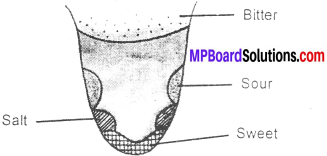
Question 10.
Write down some functions of the tongue?
Answer:
We use our tongue for taking. Besides, it mixes saliva with the food during chewing and helps in swallowing food. We also taste food with our tongue. It has so many taste buds that detect different tastes of food
Question 11.
Draw a diagram to show the movement of the food in the alimentary canal?
Answer:
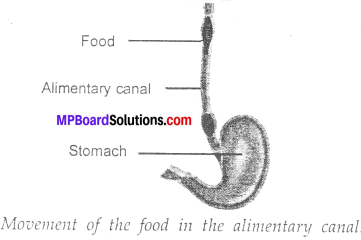
Question 12.
What is meant by diarrhoea? Explain.
Answer:
Sometime you may have experienced the need to pass watery stool frequently. This condition is known as diarrhoea. It may be caused by an infection, food poisoning or indigestion. It is very common in India, particularly among children. Under severe conditions it can be fatal. This is because of the excessive loss of water and salts from the body. Diarrhoea should not be neglected. Even before a doctor is consulted the patient should be given plenty of boiled and cooled water with a pinch of salt and sugar dissolved in it. This is called Oral Rehydration Solution (ORS).
Nutrition in Plants Long Answer Type Questions
Question 1.
Explain ingestion of food in Amoeba with diagram?
Answer:
The organs which ingests food in pseudopodium. The food is caught by encircling it with Pseudopodia. When it is totally encircled then it is taken inside cell.
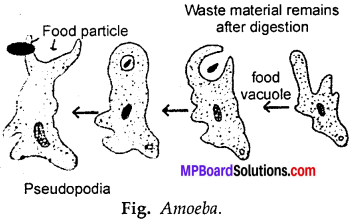
Question 2.
Describe the respiratory system of human beings?
Answer:
The various respiratory organs alongwith their functions are:
Air enters through the nostrils in the nose. The air then enters the nasal cavity which leads to larynx or voice box. From the larynx the air passes into the wind pipe or trachea. The trachea bifurcates into two branches. These are called bronchi. Bronchi further divide into smaller tubes called bronchioles. Later terminate in small thin wall air sacs called alveoli. The thin walls of the alveoli are provided with a network of blood capillaries. It is here that blood absorbs oxygen from alveoli and carbon dioxide from the blood enters the alveoli. From here the carbon dioxide is thrown out from the body. This process is called exhalation.
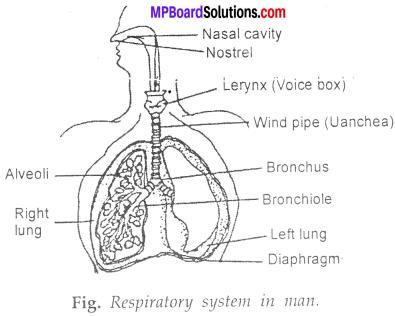
Question 3.
Describe in details the process of digestion in human beings?
Answer:
The various digestive organs and the process of digestion are:
1. Mouth, Teeth and Tongue:
The process of digestion beings with mouth. Food is taken inside the mouth, chewed into smaller pieces by the teeth. Mouth has few salivary glands which secrete saliva. The tongue helps in mixing saliva with food and swallowing the food.
2. Oesophagus:
Then the food enters into food pipe which is also called oesophagus. The wall of the oesophagus undergo peristaltic movements. This sends the food into the stomach.
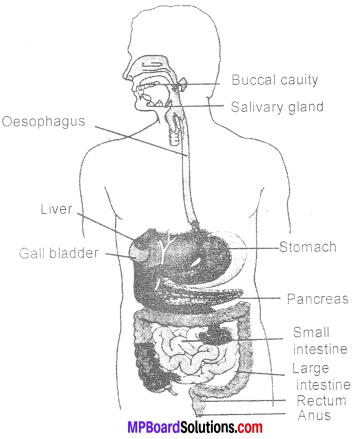
3. Stomach:
Stomach is a bag like structure. Here the digestion of food starts. Here food is thoroughly mixed with the gastric juice secreted by gastric gland present in the stomach.
4. Small Intestine:
The process of digestion continues into small intestine. The upper part of the small intestine is called duodenum. In duodenum food is mixed with bile juice made by the liver and pancreatic juice from pancreas. The digested food is absorbed in the lower part of the small intestine by tiny projections called villi.
5. Large Intestine:
The undigested food now moves to the large intestine. Here water is absorbed and solid residue left behind called faeces.
6. Rectum and Anus:
The faeces then passer to rectum and expelled from the body through the anus.
Question 4.
Draw a diagram to show the arrangement of teeth in mouth?
Answer:
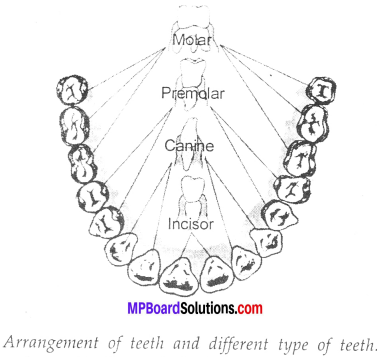
Question 5.
What is tooth decay? Explain.
Answer:
Normally bacteria are present in our mouth but they are not harmful to us. However, if we do not dean our teeth and mouth after eating, many harmful bacteria also begin to live and grow in it. These bacteria break down the sugars present from the leftover food and release acids. The acids gradually damage the teeth (Fig.). This is called tooth decay. If it is not treated in time, it causes severe toothache and in extreme cases results in tooth loss. Chocolates, sweets, cold drinks and other sugar products are the major culprits of tooth decay.

Therefore, one should clean the teeth with a brush or dantun and dental floss (a special strong thread which is moved between two teeth to take out trapped food particles) at least twice a day and rinse the mouth after every meal. Also, one should not put dirty fingers or any unwashed object in the mouth.
![]()
Question 6.
Explain excretion in human?
Answer:
Excretion is done by following organs:
1. Kidneys:
These excrete urea, salts, water etc., through urine.
2. Skin:
Skin possesses sweet glands. These glands absorb urea, salts and a large quantity of water from the blood capillaries near by and excrete them through their pores on the skin in the form of sweet.
3. Liver:
Liver is not a direct excretory organ. Liver cells convert more toxic ammonia into less toxic urea and uric acid and then pass them to the kidneys through the blood for excretion.
Liver also censer toxic substances. It remove bile salts in bile juice. These bile salts are formed due to break down of heamoglobin. If bile salts are not removed. They cause jaundice. Bile salts are removed through intestine.
4. Lungs:
It excretes gases like carbon dioxide, ammonia and water vapours.
5. Large Intestine:
It excretes undigested solid food waste (faeces).